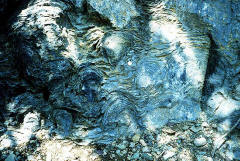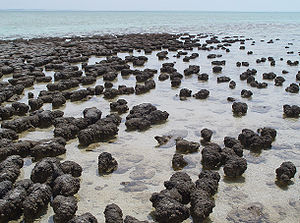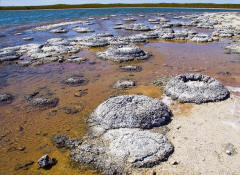|
Very few ancient stromatolites contain
fossilized
microbes. While
features of some stromatolites are suggestive of biological activity,
others possess features that are more consistent with
abiotic (non-organic)
precipitation. Finding reliable ways to distinguish between
biologically-formed and abiotic (non-biological) stromatolites is an active
area of research in geology.
Fossil Record
Stromatolites were much more abundant
on the planet in Precambrian times. While older,
|

|
|
Pre-Cambrian stromatolites in the Siyeh Formation, Glacier
National Park
|
|

|
|
Stromatolites (Pika Formation, Middle Cambrian) near Helen Lake,
Banff National Park, Canada.
|
Archean
fossil remains are
presumed to be colonies of
single-celled
blue-green bacteria,
younger (that is,
Proterozoic) fossils
may be
primordial forms of the
eukaryote
chlorophytes (that is,
green algae). One
genus of stromatolite
very common in the geologic record is
Collenia. The earliest
stromatolite of confirmed microbial origin dates to 2,724
million years ago. A
recent discovery provides strong evidence of microbial stromatolites
extending as far back as 3450
million years ago.
Stromatolites are a major constituent
of the fossil record for about the first 3.5 billion years of life on earth,
with their abundance peaking about 1,250 million
years ago. They subsequently declined in abundance and diversity, which by
the start of the Cambrian had fallen to 20% of their peak. The most
widely-supported explanation is that stromatolite builders fell victims to
grazing creatures (the
Cambrian substrate revolution),
implying that sufficiently complex organisms were common over 1 billion
years ago.
The connection between grazer and
stromatolite abundance is well documented in the younger Ordovician
evolutionary radiation;
stromatolite abundance also increased after the end-Ordovician and
end-Permian extinctions
decimated marine animals, falling back to earlier levels as marine animals
recovered.
While
prokaryotic
cyanobacteria themselves reproduce asexually through cell division, they
were instrumental in priming the environment for the development
of more complex
eukaryotic organisms.
Cyanobacteria are thought to be largely responsible for increasing the
amount of oxygen in the primeval
earth's atmosphere through
their continuing photosynthesis.
Cyanobacteria use water, carbon dioxide, and
sunlight to create
their food. The byproducts of this process are oxygen and
calcium carbonate (lime).
A layer of
mucus often forms over
mats of cyanobacterial cells. In modern microbial mats, debris from the
surrounding habitat can become trapped within the mucus, which can be
cemented together by the calcium carbonate to grow thin laminations of
limestone. These
laminations can accrete over time, resulting in the banded pattern common to
stromatolites. The domal morphology of biological stromatolites is the
result of the vertical growth necessary for the continued infiltration of
sunlight to the organisms for photosynthesis.
Modern Stromatolites
Modern stromatolites are mostly found
in
hypersaline lakes and
marine lagoons where extreme
conditions due to high saline levels exclude animal grazing. One such
location is
Hamelin Pool Marine Nature Reserve,
Shark Bay in Western Australia where
excellent specimens are observed today, and another is
Lagoa Salgada, state of
Rio Grande do Norte,
Brazil, where modern
stromatolites can be observed as bioherm (domal type) and beds. Inland
stromatolites can also be found in saline waters in
Cuatro Ciénegas, a
unique ecosystem in the
Mexican desert, and in
Lake Alchichica, a
maar lake in Mexico's
Oriental Basin. Modern
stromatolites are only known to prosper in an open marine environment in the
Exuma Cays in the Bahamas.
Freshwater stromatolites are found in
Lake Salda in southern
Turkey. The waters are
rich in magnesium and the
stromatolite structures are made of
hydromagnesite.
Layered
spherical growth structures named
oncolites are similar
to stromatolites, and are also known from the fossil record.
End of Reading
Return to the
Old Earth Ministries Online Earth
History Curriculum homepage.
Source:
Stromatolites
|



